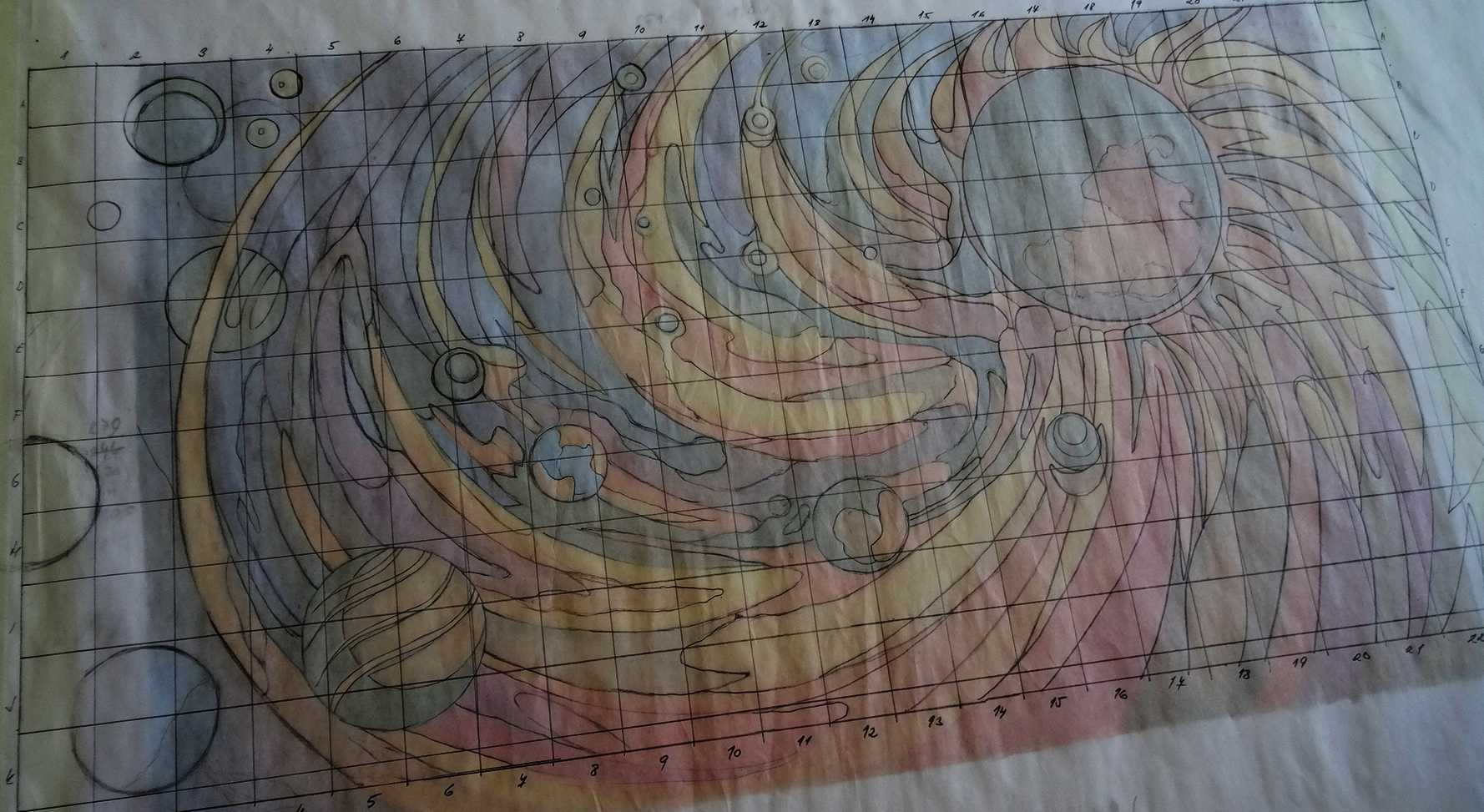
Scaled model
Messure twice, cut only once.
ENGLISH
The model of the intended fresco design must be prepared accurately, and most importantly, done in the same proportion as the wall. The most recommended measuring scale is 1 : 10, however this is up to the artist to decide, what scale is most convenient for the individual project.
The transfer of the small-scale model to the real size maquette of the fresco is done through the square grid, as shown on the illustrative photos.
The following step is transferring the real size drawing to a large transparent plastic foil which will be attached onto a wooden board above the top of the fresco to hold the plastic foil for the whole process of painting. This transparent plastic must be bigger than the fresco to protect the wall and to keep the coating damp through technological pauses. The design is traced on the plastic by unerasable felt-tip marker.
The real size maquette should be drawn on a good-quality paper to allow experimenting with colours before painting the fresco.
CZECH
Model zamýšleného motivu fresky musí být proveden ve vysoké kvalitě, a hlavně ve stejném poměru stran jako bude výsledná freska, což je limitováno rozměrem a tvarem stěny. Model se často tvoří v měřítku 1 : 10, nicméně je na rozhodnutí umělce, jaké měřítko zmenšení je pro daný projekt nejvhodnější.
Přenos modelu na maketu ve skutečné velikosti fresky se provádí přes čtvercovou mřížku, jak je znázorněno na ilustračních fotografiích.
Následujícím krokem je přenesení návrhu ve skutečné velikosti na velkou průhlednou plastovou fólii, která bude připevněna na dřevěnou lištu nad horním okrajem fresky po celou dobu výmalby. Folie by měla být větší než freska, aby chránila zeď a udržovala vlhkost omítky během technologických přestávek. Linie motivu se na průhlednou fólii obtahují nesmazatelným lihovým fixem.
Maketa ve skutečné velikosti by měla být slepena z kvalitního papíru, aby bylo možné provést zkoušky barevnosti pigmentů ještě před malováním do omítky.
POLISH
Makieta zamierzonego fresku musi być wykonana dokładnie, a co najważniejsze, w takiej samej proporcji jak ściana. Najbardziej zalecana skala to 1 : 10, jednak to od artysty zależy jaka skala jest najwygodniejsza dla indywidualnego projektu.
Makietę w rozmiarze rzeczywistym należy wykonać na papierze dobrej jakości, aby umożliwić eksperymentowanie z kolorami przed malowaniem fresku.
Przeniesienie modelu z małej skali do makiety fresku w rzeczywistych rozmiarach odbywa się za pomocą kwadratowej siatki, jak pokazano na zdjęciach poglądowych.
Następnym krokiem jest przeniesienie rysunku w rozmiarze rzeczywistym na dużą przezroczystą folię plastikową, która zostanie przymocowana do drewnianej deski nad freskiem, aby ułatwić proces malowania. Użyta folia musi być większa niż fresk, aby chronić ścianę/fresk przed czynnikami zewnętrznymi oraz utrzymać prawidłową wilgotność tynku podczas przerw technologicznych. Projekt powinien być przerysowany na folię nieusuwalnym flamastrem.
GERMAN
Die Vorlage zum beabsichtigten Freskendesign muss genau und vor allem im gleichen Verhältnis wie die Wand hergestellt werden. Der am meisten empfohlene Maßstab ist 1:10, jedoch ist es Sache des Künstlers zu entscheiden, welcher Maßstab für das individuelle Projekt am praktischsten ist.
Die Übertragung der Vorlage in kleinem Maßstab auf das Modell des Freskos in Originalgröße erfolgt durch das quadratische Gitter, wie auf den Fotos gezeigt.
Der folgende Schritt besteht darin, die Zeichnung in Originalgröße auf eine große transparente Plastikfolie zu übertragen, die auf einer Leiste über der Oberseite des Freskos befestigt wird, um die Plastikfolie für den gesamten Malprozess verwenden zu können. Diese transparente Folie muss größer sein als das Fresko, um die Wand zu schützen und die Beschichtung über notwendige Pausen feucht zu halten. Die Konturen der Vorlage werden mit einem nicht wasserfesten Folienmarker auf die Folie übertragen.
Der Papierentwurf in Originalgröße sollte auf hochwertigem Papier ausgeführt werden, damit vor dem Malen des Freskos mit Farben darauf experimentiert werden kann.
FRENCH
La maquette de la fresque doit être préparée avec précision et, surtout, dans les mêmes proportions que le mur. L'échelle de mesure la plus recommandée est 1:10, mais c'est à l'artiste de décider quelle échelle est la plus appropriée pour son projet. L'agrandissement de la maquette à la taille réelle de la fresque se fait grâce à un quadrillage, comme le montrent les photos. La maquette à taille réelle doit être exécutée sur un papier de bonne qualité pour permettre d'expérimenter les couleurs avant de peindre la fresque.
L'étape suivante consiste à transférer le dessin en taille réelle sur une grande feuille de plastique transparente qui sera fixée sur une planche de bois en haut de la fresque pour maintenir la feuille de plastique pendant tout le processus de peinture. Ce plastique transparent doit être plus grand que la fresque pour protéger le mur et garder le revêtement humide pendant les pauses. Le dessin est tracé sur le plastique par un feutre permanent.

The European Commission's support for the production of this publication does not constitute an endorsement of the contents, which reflect the views only of the authors, and the Commission cannot be held responsible for any use which may be made of the information contained therein.
